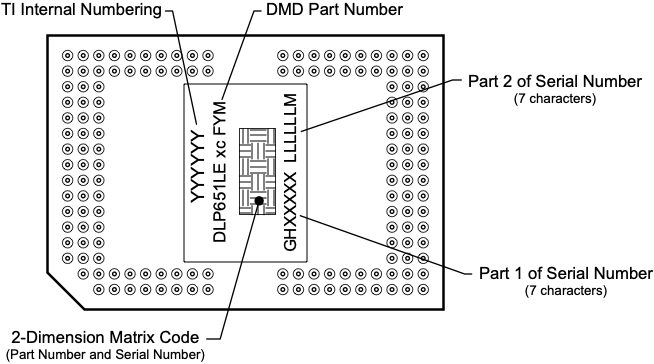DLPS153 October 2023 DLP651LE
PRODUCTION DATA
- 1
- 1 Features
- 2 Applications
- 3 Description
- 4 Revision History
- 5 Pin Configuration and Functions
-
6 Specifications
- 6.1 Absolute Maximum Ratings
- 6.2 Storage Conditions
- 6.3 ESD Ratings
- 6.4 Recommended Operating Conditions
- 6.5 Thermal Information
- 6.6 Electrical Characteristics
- 6.7 Timing Requirements
- 6.8 System Mounting Interface Loads
- 6.9 Micromirror Array Physical Characteristics
- 6.10 Micromirror Array Optical Characteristics
- 6.11 Window Characteristics
- 6.12 Chipset Component Usage Specification
-
7 Detailed Description
- 7.1 Overview
- 7.2 Functional Block Diagram
- 7.3 Feature Description
- 7.4 Optical Interface and System Image Quality Considerations
- 7.5 Micromirror Array Temperature Calculation
- 7.6 Micromirror Power Density Calculation
- 7.7 Window Aperture Illumination Overfill Calculation
- 7.8 Micromirror Landed-On/Landed-Off Duty Cycle
- 8 Application and Implementation
- 9 Layout
- 10Power Supply Recommendations
- 11Device and Documentation Support
- 12Mechanical, Packaging, and Orderable Information
Package Options
Mechanical Data (Package|Pins)
- FYM|149
Thermal pad, mechanical data (Package|Pins)
Orderable Information
11.1.2 Device Markings
The device marking will include both human-readable information and a two-dimensional matrix code. The human-readable information is described in Figure 11-2. The two-dimensional matrix code is an alpha-numeric string that contains the DMD part number, Part 1 and Part 2 of the serial number.
 Figure 11-2 DMD Marking Locations
Figure 11-2 DMD Marking Locations